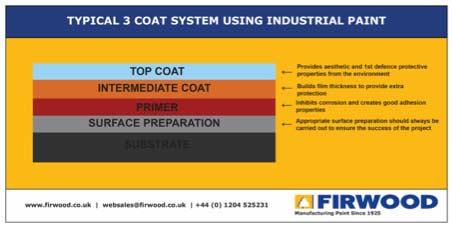Paint serves the primary purpose of forming a protective film on surfaces once applied. This serves several important functions:
- Protection: Paint shields surfaces from weathering, extending their lifespan.
- Decoration: It enhances the appearance of dull or unattractive surfaces with colour.
- Other uses: Paints can also seal surfaces for hygiene or serve as identification markers.
Varnish shares similar functions with paint, primarily used on wood but applicable to other materials. Varnishes are transparent with a slight colour tint, preserving the natural texture and appearance of wood.
In contrast to paints, stains (and varnishes to a lesser extent) penetrate surfaces for colouring. Since stains do not create a protective film, they are used solely for decorative purposes.
For more detailed information, visit our comprehensive guide on Varnishes and Stains.
Understanding Paints: Composition and Uses
After applying paint, the film must fulfil three essential roles:
- Conceal the underlying surface
- Adhere firmly to the surface
- Provide protection to the underlying surface
These functions are primarily achieved through three key components: pigment, binder, and carrier. Additionally, paints may contain various other additives. Let’s explore these components in detail:
Pigments in Paints
Pigments provide colour and opacity to the paint film. Traditionally, these were sourced from minerals, earth minerals, plants, or other organic materials. For instance, purple in Roman times was derived from snail mucus.
Since the industrial revolution, metal compounds, salts, and synthetic pigments have become common. Notably, White Lead (lead carbonate), once widely used, is now banned due to its toxicity.
Recently, there’s been a revival in using natural pigments for their deeper and richer colours. Suppliers offering paints with natural pigments can be found on our eco-friendly paints project.
Pigments are mixed with other paint ingredients to ensure even coverage when applied. They are typically suspended rather than dissolved, which means they can settle if the paint sits too long. Always mix your paint thoroughly before use for consistent results.

Representation of the relative amounts of ingredients in paints
Paint Binders
The binder’s primary role is to hold paint particles together, forming a continuous film as the paint dries, and to adhere the paint to surfaces.
In traditional paints, binders like glue size or linseed oil were used, but modern paints typically employ synthetic resins such as alkyd, acrylic, vinyl, or polyurethane.
Beyond adhering pigment to surfaces, binders also provide protective layers by forming a durable film. They are usually too viscous to apply directly, so they require thinning.
Paint Carrier or Thinners
The carrier, also known as the solvent, ensures smooth application of paint onto the surface. As the paint dries, this component evaporates. Depending on the type of binder used, the carrier can be water-based or solvent-based.
The binder and carrier together are often referred to as the “vehicle” because they transport the pigment, ensuring even coverage on the surface.
Most paints used for home improvement come pre-mixed, eliminating the need to thin them before application—just thorough mixing is required. An exception is when applying a mist coat on very porous surfaces like new plaster, where the carrier is quickly absorbed.
Learn more about this in our painting new plaster project.
Paint Additives
Additives are compounds added to paint to enhance its properties beyond the basic components. While essential components like pigment, binder, and carrier are necessary, additives are optional but widely used.
They serve various purposes such as improving flow, adjusting drying times, enhancing durability against water, rust, and mildew. Additives can also bolster UV resistance and promote better adhesion to surfaces like metal.
These are just a few examples of how additives can enhance paint performance.
Types of Paint for Interior Walls
Explore our comprehensive PDF guide detailing the various types of paint used for interior walls and their best applications.

Download our guide to understand different paint types
Domestic paints vary based on their vehicle types (binders and carriers). There are two primary categories:
Emulsion Paints
Emulsion paints are water-based, utilising water as their carrier which evaporates as the paint dries.
In these paints, pigments and binders are suspended in water as tiny droplets, resembling a milky emulsion. In the USA, these are commonly known as Latex paints. As the water evaporates, these droplets merge to form the paint film.
Modern emulsion paints incorporate acrylic or vinyl resins to enhance their performance over traditional types. This addition increases the paint’s durability, sheen, and hardness.
Primarily used for indoor applications like walls and ceilings, there are also specialised emulsions available for wood and other surfaces.
Solvent-Based Paints
Solvent-based paints use an oil binder and a petroleum-based solvent as the carrier.
Alkyd paints, a common type, have their binder and pigment dissolved in the solvent. These paints dry slower compared to water-based paints (known as oil-based paints in the USA).
One characteristic of solvent-based paints is the strong smell during drying, which many find unpleasant.
Due to increasing concerns over health risks from solvent inhalation, these paints are becoming less popular.
Thixotropic paints, also known as non-drip, include additives that enhance performance, allowing for easier loading onto brushes and thicker application.
In many cases, a single coat of this type of paint may suffice.

Understanding the different types of paint helps when it comes to choosing the right one – Image courtesy of Homeey
Types of Paint Finishes
Besides the main types of paint, various names are used to describe different levels of gloss found on paint cans.
These descriptions indicate the level of shine the paint will have, ranging from Gloss to Matt. Here are some common paint finish names you’ll encounter:
- Gloss: Typically oil-based, highly durable, and often referred to as “Liquid Gloss”. Polyurethane Gloss, made with polyurethane, offers an exceptionally tough finish.
- Satinwood: Slightly less glossy and less hardwearing than Gloss paints.
- Eggshell: Between Gloss and Matt, often used for internal finishing like architraves and skirting.
- Matt: Completely non-reflective, ideal for walls and ceilings to avoid any light reflection.
For interior decoration, Vinyl Emulsion paints are commonly used for walls and ceilings, offering their own range of finishes:
- Silk: High sheen and very durable, suitable for high moisture areas like bathrooms and kitchens.
- Satin: Less durable than Silk with moderate sheen, suitable for walls that may need occasional washing.
- Matt: No gloss and less durable compared to others, preferred for walls as it hides imperfections well.
Paint Systems Explained
Applying a single coat of paint is rarely sufficient; a proper paint system involves multiple coats tailored to the specific paint and surface.
The sequence typically includes:
- Sealer: Used to seal the surface where necessary.
- Primer: Provides a good base for the paint film to adhere to.
- Undercoat: Builds up a uniform, non-absorbent base layer, preparing for the final coat.
- Top Coat: Provides the desired colour and finish.

An illustration of a 3-coat paint system – Image courtesy of Firwood Paint
Dedicated primers and undercoats are often available separately or as a combined product.
While a combined primer and undercoat may be convenient, separate applications generally offer better results. Understanding their distinct roles explains why:
- Primer: Prepares the surface for paint adhesion, preventing absorption into materials like wood, metal, or plaster. Choose specific primers suitable for your surface type.
- Undercoat: Applied under the finishing coat(s) to ensure uniform colour and coverage, especially useful for oil paints or when changing colours.

Applying Paint in a system helps to get a quality, lasting finish – Image courtesy of Dulux
Specialist Paints Explained
Specialist paints cater to specific needs around the home. Here are the most common types:
- Radiator Paint: Designed for radiators and heating pipes to withstand high temperatures without cracking or discolouration.
- Fire Retardant Paints (Intumescent Paints): Slows the spread of fire, essential for protecting structural elements like beams and doors.
- Anti-Condensation Paint: Ideal for high-moisture areas like bathrooms and kitchens, maintaining higher surface temperatures to reduce condensation levels, often with added mould and mildew resistance.
- Eco-Friendly Paints: Environmentally friendly options gaining popularity due to improved performance and natural pigment colours.
- Masonry and Tile Paints: Specifically formulated for stone, brick, and tiles, offering durability and adherence.
- Metal Paints: Designed for metal surfaces, including rust prevention paints that protect against rust and restore damaged areas.

Radiator paint is essential for painting radiators

Various paints for anti-condensation, anti-mould, and stain prevention
Paints are available for nearly every surface and task. Researching the right type of paint for your specific project is crucial.
With this understanding of different paint types, choosing the perfect paint for your next project should be much simpler.

